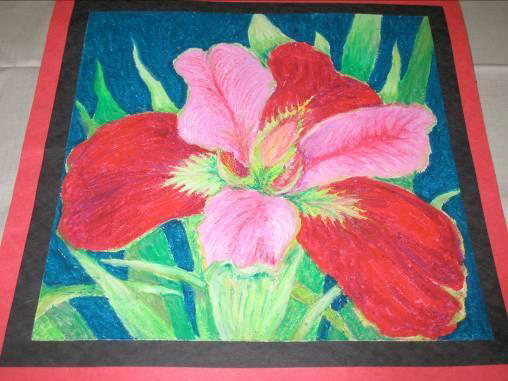American artist, Georgia O’Keeffe, created large closeup views of single flowers in many of her paintings. Using O’Keeffe’s realistic style, students will learn color shading and composition using oil pastels to create their own flowers
Goal (Terminal Objective):
Students will develop skills in color, shading, and composition with oil pastels to create a flower drawing in the style of Georgia O’Keeffe.
Objective:
Students will be introduced to the life and work of American artist, Georgia O’Keeffe. Students will demonstrate their knowledge of color, shading, and composition using oil pastels to create flower drawings which appear three dimensional.
National Standards:
Visual Arts Grades 5-8 Content Standard 1: Understanding and applying media, techniques, and processes
Visual Arts Grades 5-8 Content Standard 5: Reflecting upon and assessing the characteristics and merits of their work and the work of others
Visual Arts Grades 5-8 Content Standard 6: Making connections between visual arts and other disciplines (Science Cross Curriculum Connection)
Purpose:
Students will observe closeup photos of flowers in seed and garden catalogs to provide the inspiration and details for their own closeup flower composition.
New Vocabulary:
Georgia O’Keeffe, composition, shading, threedimensional, realism
Materials:
White Drawing Paper 11” squares

#22-2016 Oil Pastel lg.
Introduction and Motivation (Set):
Discuss the life and work of Georgia O’Keeffe. Read “My Name is Georgia: A Portrait by Jeanette Weaver” if available. Show visuals of O’Keeffe’s flowers, pointing out the closeup view, composition, and shading which creates the threedimensional effect.
Instruction:
Using a flower visual from a seed catalog, the students should make a closeup sketch of a flower paying careful attention to overlapping petals. The flower should touch the edges of the paper.
Demonstrate how to color solidly with oil pastels and shade with other colors to make a three dimensional petal. Avoid using black to shade darker. (I often remove the black oil pastels before getting started.) Continue the coloring of the flowers and leaves. Add final details of stamen, pistol, etc., and then color the background a solid color that enhances the flower drawing.
Activities:
(1) Guided Practice:
- Students select a flower and sketch it large enough on their paper so that it touches all edges of the paper. Choose a color to sketch with that is in the flower petals.


Using the oil pastels, students will color and use shading to make the individual flower petals look three dimensional. After the petals and leaves have been shaded, the flower details and background are to be colored to complete the drawing.
(2) Independent Practice and Check for Understanding:
The teacher will circulate around the students checking for mastery of the concept of shading with color. The teacher will offer help if the student is having difficulty and positive reinforcement when the concept is understood.
(3) Closure:
Each student’s artwork will be mounted on a 12” square background paper and displayed.
Evaluation:
The teacher will evaluate the artwork based on the following criteria:
Level One – The completed oil pastel flower drawing looks very real and three dimensional. The student’s drawing demonstrates great color, shading, composition, craftsmanship, and skill with oil pastels.
Level Two - The completed oil pastel flower drawing has a good composition and is colored carefully, but there is only limited use of shading. The flower looks flat and lacks depth.
Level Three – The completed oil pastel flower drawing shows minimal effort to make the flower look real. The flower does not fill the entire space in the drawing as in O’Keeffe’s flower paintings.
Level Four – The oil pastel flower drawing is not completed. The student has not made an attempt to complete the objective of this lesson.
Tips:
If you would rather students draw from real flowers than a photo, check at your local florist for blooms that are past their peak for resale. Many florists throw away flowers daily and would gladly donate them for your students’ drawings.
Notes:
Encourage the students to press hard and color solid with the oil pastels. Colors can be layered to create shading. Students may need individual guidance if this is their first attempt to shade realistically.
Extension:
The students can use their newly acquired knowledge of shading in color for a still life or portrait drawing.
Resources:
http://en.wikipedia.org/wiki/GeorgiaO’Keeffe
http://www.okeeffemuseum.org
http://www.ellenspace.net/okeeffe/.html
http://waysidegardens.com/home
Art Consultant



